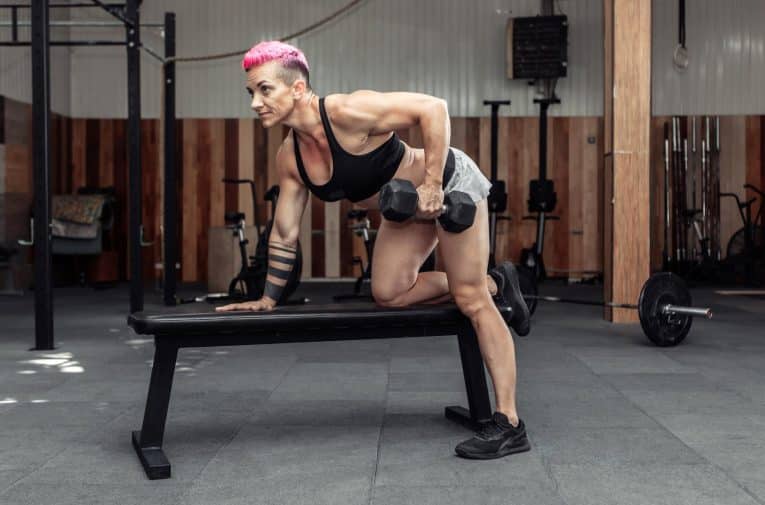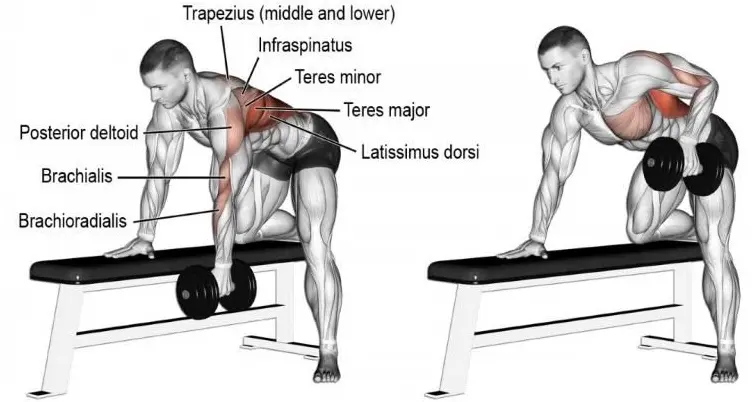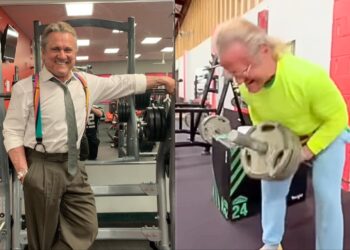The single-arm dumbbell row is a popular back exercise. It is not as despised as the deadlift or brushed aside like the straight-arm cable pulldown. The single-arm dumbbell row sits in the middle, leaving you with a muscle-ripping pump and delivering results.
This back exercise is one of the few free-weight exercises with a dedicated space in gyms. The heaviest dumbbells, which are stored in a corner and usually covered with dust, are used for the single-arm dumbbell row.
The gold-plated 330-pound dumbbells are the biggest dumbbell in Gold’s Gym, Venice Beach, CA. Lifters usually attempt a single-arm dumbbell row with these monsters. Despite the titans that visit the Mecca of Bodybuilding, you never see a lifter attempt a shoulder or chest press with these goldies.
This article covers everything you need to know about the single-arm dumbbell row and how to master the movement. We also delve into its target muscles, benefits, common mistakes, variations, and alternatives.
What is Single-Arm Dumbbell Row?

Back workouts mainly consist of two types of movements — horizontal and vertical pulling. The horizontal pulling movements like the lat pull-down and pull-up help improve your back width, whereas horizontal pulling exercises like the single-arm dumbbell row build your back thickness.
Level Up Your Fitness: Join our 💪 strong community in Fitness Volt Newsletter. Get daily inspiration, expert-backed workouts, nutrition tips, the latest in strength sports, and the support you need to reach your goals. Subscribe for free!
The single-arm dumbbell row is a strength training compound (multi-joint) exercise that can help boost hypertrophy and strength gains. The back exercise is a staple movement in most back training routines and targets the lats while also working the shoulders, biceps, and core. The single-arm dumbbell row works the lats through their full range of motion.
You can do the single-arm dumbbell row on a flat bench or with your feet planted on the floor while leaning on an elevated object like an incline bench or a dumbbell rack. Each variation works the target muscles differently.
Although the single-arm dumbbell row is a fairly simple exercise, most lifters leave gains on the table by eluding the correct form. Following the correct form helps achieve better muscle stimulation, establish a mind-muscle connection, and deliver a muscle-ripping pump.
Muscles Worked During Single-Arm Dumbbell Row
The compound exercise works the following muscles:

Latissimus Dorsi
The latissimus dorsi, or the lats, as they are lovingly called, are the primary target muscles of the single-arm dumbbell row. They are the biggest back muscle and give your back its width and thickness.
Your lats are large V-shaped muscles connecting your arms to your vertebral column. They protect and stabilize your spine, help with shoulder and arm movement, and support good posture. You must ensure a full range of motion to train this muscle group optimally.
Rhomboids
Rhomboids (major and minor) enable upper limb movement and help with shoulder girdle and scapula stability. They are located between the shoulder blades and help retract the scapula and maintain proper posture. The single-arm dumbbell row also works the teres major and minor and rear deltoids.
Traps
The single-arm dumbbell row involves a shrugging movement in the lift’s concentric (upward) part. Traps extend from the neck to the middle of the back and help with scapula movement.
Biceps
Most pulling movements involve biceps engagement; the single-arm dumbbell row is no different. You can limit biceps involvement by focusing on pulling through your elbow. Use your hands as hooks and drive your elbow toward the roof while keeping it close to your side for optimal lat stimulation.
Forearms
Forearm muscles are recruited in gripping the dumbbell in the single-arm dumbbell row. The harder you grip the dumbbell handle, the more muscle fibers you’ll experience firing in your forearms.
Core
Most lifters go heavy on the single-arm dumbbell row. You need a strong core to maintain your torso almost parallel to the floor. Brace your core for optimal stability. We recommend wearing a weightlifting belt for better thoracic power and safety while performing this exercise.
Benefits of Single-Arm Dumbbell Row
Given below are the advantages of adding the single-arm dumbbell row to your training regimen:
Build Strength and Muscle Mass
The single-arm dumbbell row is a strength training exercise that helps boost strength and muscle mass in the back. You can change your exercise programming depending on your goals. Perform 1-5 reps with heavy weights if you want to boost your strength. Alternatively, perform 8-12 reps for improved physique aesthetics. [1]
Unilateral Training
The single-arm dumbbell row is a unilateral exercise, meaning you can work one side of your body at a time. Unilateral exercises are incredibly effective at fixing muscle and strength imbalances.
Improves Posture
The compound exercise can fix muscle and strength imbalances, helping improve your posture. A good posture can reduce injury risk while training and minimize posture-related issues.
Better Grip Strength
Most intermediate lifters and above go heavy on the single-arm dumbbell row. Lifting heavy dumbbells can improve your grip strength and can also help build bigger and girthier forearms.
Enhanced Core Stability
Since this is a bent-over single-arm back exercise, it demands greater core stability to hold your back almost parallel to the floor. The double-arm bent-over dumbbell row also requires core stability, but lesser than the single-arm variation as you don’t go as heavy on this lift. Plus, the single-arm dumbbell row requires you to maintain a square chest, which puts a greater demand on your obliques.
Requires Minimal Equipment
The single-arm dumbbell row is a great exercise whether you train at your garage gym or a commercial training facility. You require only one dumbbell, meaning folks who train at commercial gyms during rush hours shouldn’t have a problem doing this exercise.
How To Do Single-Arm Dumbbell Row
Make the most of the single-arm dumbbell row by following the directions mentioned below:
Steps
- Place a dumbbell on the floor on the right side of a flat bench.
- Stand on one end of the bench.
- Place your left knee on the end of the flat bench and plant your left hand on the bench so that it is directly under your shoulder.
- Plant your right foot on the floor in line with your left knee.
- Bend down and grab the dumbbell in your right hand with a neutral grip (palm facing inward).
- At the starting position, your shoulders should be in line and your back flat and parallel to the floor.
- Brace your core and glutes to stabilize your hips.
- Pull your shoulder blades back and down. Drive your elbow toward the ceiling while keeping it close to your body.
- Pause and contract your lat at the top.
- Slowly return to the starting position.
- Lower the dumbbell toward the floor for optimal lat stretch.
- Repeat for recommended reps before changing sides.
Tips
- While you could do this exercise without placing your hand on a flat bench or other elevated surfaces, using support will help you lift heavier, resulting in better muscle stimulation.
- Keep your head neutral throughout the exercise. Looking ahead will put unnecessary stress on your neck.
- Do not use momentum by swinging your working side up and down.
- Switch to a monkey grip (thumb around the handle) if you feel excess biceps stimulation.
- Do not lift your shoulder toward the ceiling during the concentric (upward) movement. Keep your shoulder and chest square throughout the range of motion.
This Exercise:
- Target Muscle Group: Back
- Secondary Muscles: Shoulders, Biceps, Forearms, and Calves
- Type: Strength
- Mechanics: Compound
- Equipment: Dumbbell
- Difficulty: Beginner
- Best Rep Range:
- Hypertrophy: 8-12
- Strength: 1-5
Common Mistakes While Performing Single-Arm Dumbbell Row
Here are some recurrent mistakes that lifters commit while performing the single-arm dumbbell row:
Using Momentum
Most lifters use momentum while doing the single-arm dumbbell row by moving their working side up and down. Swinging up and down while performing the exercise removes tension from your target muscles and puts it on your shoulder and biceps.
Keep your reps slow and controlled. You shouldn’t look like a crude oil pumpjack while performing the single-arm dumbbell row.
Incorrect Posture
Ensure that you maintain a flat back throughout the exercise. Rounding your back or dipping your lower back and pushing out your chest will remove tension from the lats. You must maintain a neutral torso while performing the single-arm dumbbell row.
Dropping Your Shoulder at the Bottom
Many lifters touch the dumbbell to the floor at the bottom of the movement, hoping to achieve better lat stimulation. This overextension during the eccentric (downward) part of the lift can put you at a higher risk of injury.
Not Engaging Your Core
If you notice yourself using momentum while performing the single-arm dumbbell row, it is likely because you are not actively engaging your core. Bracing your core while performing this lift will provide stability and reduce the risk of straining your back.
Level Up Your Fitness: Join our 💪 strong community in Fitness Volt Newsletter. Get daily inspiration, expert-backed workouts, nutrition tips, the latest in strength sports, and the support you need to reach your goals. Subscribe for free!
Flaring Your Elbows
You must keep your elbow close to your side to contract your lats at the static contraction point at the movement’s top. Flaring your elbows will reduce lat engagement and put more focus on the scapula.
Not Using a Full Range of Motion
Most lifters leave gains on the table by limiting their range of motion. A limited range of motion is especially prevalent while using heavier weights. The dumbbell should touch your torso at the top. Following a full range of motion allows optimal muscle fiber recruitment.
Variations and Alternatives of Single-Arm Dumbbell Row
Train your back from different angles using the following single-arm dumbbell row alternatives and variations:
Chest-Supported Dumbbell Row
The chest-supported dumbbell row takes your core out of the equation. It is a great single-arm dumbbell row variation for folks who struggle to balance their torso.
Steps:
- Position an incline bench at a 45-degree angle with the floor.
- Lie prone on the bench.
- Grab a dumbbell in each hand using a neutral grip. Plant your feet on the floor on either side of the bench.
- Drive your elbows toward the ceiling while retracting your shoulder blades.
- Pull the dumbbells towards your sides until your elbows are behind your body.
- Pause and contract at the top.
- Slowly lower the dumbbells to the starting position.
- Repeat for desired repetitions.
Pro Tip: Place your lower legs on the incline bench seat if you want more core engagement.
Check out our complete chest-supported dumbbell row guide here!
Inverted Row
The inverted row is a bodyweight exercise that might look easy but will have you on your knees by the time you are done with it.
Steps:
- Adjust a Smith machine barbell at waist height, so your back does not touch the floor at the bottom of the movement.
- Lie supine on the floor so that your chest is under the barbell.
- Grab the Smith machine bar with a slightly wider than shoulder-width overhand grip.
- Plant your heels on the floor. Your body should be in a straight line from head to heel throughout the exercise.
- Lift your body off the floor. This will be the starting position.
- Pull your upper body to the bar by bending at your elbows.
- Pause and contract your lats at the top.
- Slowly return to the starting position.
- Repeat for reps
Pro Tip: Keep your chest pulled out throughout the exercise. Use a weighted vest to make this exercise harder.
Check out our complete inverted row guide here!
Barbell Row
The barbell row is one of the most popular back exercises. It is a compound (multi-joint) lift that helps build muscle size and strength. It is a great single-arm dumbbell row alternative if you want to go super heavy.
Steps:
- Stand upright with a shoulder-wide stance.
- Grab a barbell with both hands using a pronated grip.
- Bend forward while pushing your hips back and maintaining a slight bend in your knees.
- Your torso should be at least at a 30-degree angle with the floor while performing the exercise.
- Pull the barbell to your stomach while driving your elbows toward the ceiling.
- Keep your elbows close to your body.
- Pause and contract at the top.
- Return to the starting position.
- Repeat for desired reps.
Pro Tip: Do not use momentum by swinging your torso back and forth.
Check out our complete barbell row guide here!
Seated Cable Row
The cable keeps constant tension on your lats in this horizontal pulling movement. Follow a full range of motion to get the most out of this exercise.
Steps:
- Sit on the cable row machine.
- Select the appropriate weight on the stack and attach a straight bar to the pulley.
- Grasp the bar with an overhand grip.
- Keep your legs slightly bent and your back straight.
- The weight should be off the stack at the starting position. Your torso should be upright, and your shoulders should be pulled back and down.
- Without learning back, pull the handle into your stomach.
- Pause and contract your lats at the top.
- Slowly return to the starting position.
- Repeat for reps.
Pro Tip: Do not overextend your back during the eccentric phase of the lift.
Check out our complete seated cable row guide here!
Renegade Row
Besides your lats, the renegade row is a great exercise for your core.
Steps:
- Get into a high plank position while holding a dumbbell in each hand using a neutral (palms facing inward) grip.
- The dumbbells should be directly under your chest.
- While keeping your shoulders and chest square, pull the right dumbbell toward your side until it touches your torso.
- Slowly return to the starting position.
- Repeat on the left side.
- Alternate between sides for desired reps.
Pro Tip: Prevent your back from rounding or sagging to avoid unnecessary tension on your lower back. Maintain a flat back throughout the exercise.
Check out our complete renegade row guide here!
FAQs
Is the single-arm dumbbell row better than the double-arm dumbbell row?
The single-arm dumbbell row allows you to lift heavier than the double-arm variation. Plus, since it is a unilateral exercise, it is better at fixing strength and muscle imbalances. If your goal is to build strength and muscle mass, we recommend the single-arm dumbbell row over the double-arm exercise. You must, however, alternate between the two in your training regimen to ensure variety.
Can I replace barbell rows with dumbbell rows in my training regimen?
Both exercises train your back from different angles. The barbell variation allows you to lift heavier and demands higher core recruitment. You, however, shouldn’t choose one over the other. Both deserve a place in your training routine. Doing both exercises can make your workouts more enjoyable.
Why do I get a biceps pump while doing the single-arm dumbbell row?
Feeling a little biceps recruitment while doing the single-arm dumbbell row is expected. A biceps pump, however, is a sign that you are using too much weight, momentum, or overlooking your posture and form. Pulling the dumbbell toward your hips instead of your shoulders can reduce your biceps engagement.
Wrapping Up
The back is the second-biggest muscle group and requires a lot of variation for optimal stimulation and growth.
The single-arm dumbbell row is a functional exercise that can help build strength and muscle mass and improve your performance in daily activities. Add this unilateral exercise to your training regimen for building a V-taper.
You could also add the variations and alternatives in this article to your exercise arsenal for variety. Best of luck!
References
- Krzysztofik M, Wilk M, Wojdała G, Gołaś A. Maximizing Muscle Hypertrophy: A Systematic Review of Advanced Resistance Training Techniques and Methods. Int J Environ Res Public Health. 2019 Dec 4;16(24):4897. doi: 10.3390/ijerph16244897. PMID: 31817252; PMCID: PMC6950543.
Interested in measuring your progress? Check out our strength standards for Chest Supported Dumbbell Row, Seated Cable Row, Deadlift, and more.








